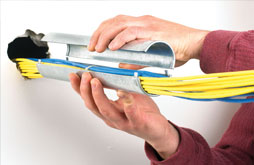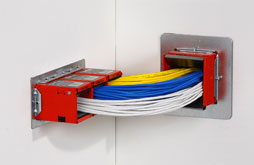

Fire Barrier Maintenance for Hospitals
By Grainger Editorial Staff 2/7/18
Fire safety is always top-of-mind for many healthcare facility managers. According to the National Fire Protection Association (NFPA), an average of five fires occur each day at U.S. healthcare facilities, and more than 8,000 hospital fires occur each year.
While "active" fire prevention methods such as smoke and fire detectors, fire sprinklers and alarms have helped save lives, they can fail because of poor maintenance or inadequate water pressure. Building codes now require the use of "passive" fire prevention measures. Among the least understood are firestop materials. These range from caulks, putties, sprays, mortar, wrap strips and collars to devices such as fire-rated cable pathways. All are designed to contain a fire to its point of origin should more primary systems fail.
In addition to safety concerns, hospitals must also comply with requirements of The Joint Commission. This independent, nonprofit group periodically arrives unannounced to survey U.S. hospitals to ensure they comply with commission standards in areas ranging from patient safety to hospital management. One particular area of concern for the Joint Commission is that any penetration above the ceiling, such as those for telecom, electrical and piping services, must be properly sealed to maintain the integrity of fire-rated walls. Unsealed or improperly sealed fire barriers can jeopardize a facility’s fire barrier integrity, expose it to needless liability and place its accreditation status in peril, which if lost, can strip a hospital of its Medicare and Medicaid funding.
Constant Change
Why is it so important for healthcare facilities to actively maintain their fire barriers on an ongoing basis? Three major reasons include life safety, compliance with regulations such as the NFPA’s Life safety Code®, and avoiding business interruption due to fire. The big challenge for hospitals, especially large teaching hospitals, is that they typically have more fire-rated compartments and endless change than other occupancies, says John Hurley of Olympia, Wash., Western Regional Manager for Specified Technologies, Inc. (STI), a firestop products manufacturer based in Somerville, N.J.
Firestop sleeve kits seal fire, smoke and superheated gas paths
Far too many people assume that once a building is built and is firestop-compliant, it stays compliant after occupancy begins," John says. "But it doesn’t." For example, hospital staff may need to relocate or add phone jacks, which prompts a contractor to come in, set up a ladder, displace ceiling tiles, move wires around and possibly cut a hole in a wall to run new wires. Where there are existing cables penetrating a wall, cable technicians may remove the existing firestop material to perform the work and not replace it. "The key for hospitals is managing barrier integrity in the face of almost constant change over the long term," John adds.
In any facility, stopping flames, toxic smoke and superheated gases is the most obvious reason to properly seal fire barriers. At healthcare facilities, there are additional risks. For example, firestopped openings can increase health risks by allowing a pathway for the movement of dust and other particles, so properly installed fire barriers help ensure infection control.
Firestop Solutions
Firestop caulks and putties are perhaps the most common and economical method for fire containment and compliance. These are often used in applications such as voice and data cabling, pipes, ductwork and joints. Most firestop caulks use intumescent technology, meaning they expand with heat to create a barrier to fire, smoke and gases.
EZ-Path® products make for easy cable moves and changes
Another option is firestop pillows. These products typically consist of mineral fiber which is treated with material that will expand when heated. The fiber is packaged in a bag and compressed into wall, ceiling or floor openings where it will expand if exposed to fire, creating a smoke- and fire-resistive barrier. Once installed, firestop pillows can be removed during cable additions and replaced without damaging the fire barrier.
A third solution is a self-contained, fire-rated pathway for cables and wires, such asEZ-Path®from STI. These pathways are designed to accommodate future cable and wire needs, eliminating the need to construct new pathways when cables are added. They can also save maintenance costs and reduce safety and liability risks.
Correct application of firestop products is crucial, but it’s just one part of an effective firestop plan. Facility managers should also conduct ongoing staff training, and closely monitor barrier changes and contractor work, John advises.
Whatever the eventual solution may be, it all starts with an on-site barrier integrity assessment. This assessment can help you determine whether or not your healthcare facility is baseline compliant, and can help you create a plan to improve fire barriers to better protect patients, staff, visitors and your business.
Sources include:
The Joint Commission, National Fire Prevention Association, Occupational Health & Safety Magazine, and Specified Technologies, Inc.
Related Link:
![]()
The information contained in this article is intended for general information purposes only and is based on information available as of the initial date of publication. No representation is made that the information or references are complete or remain current. This article is not a substitute for review of current applicable government regulations, industry standards, or other standards specific to your business and/or activities and should not be construed as legal advice or opinion. Readers with specific questions should refer to the applicable standards or consult with an attorney.








